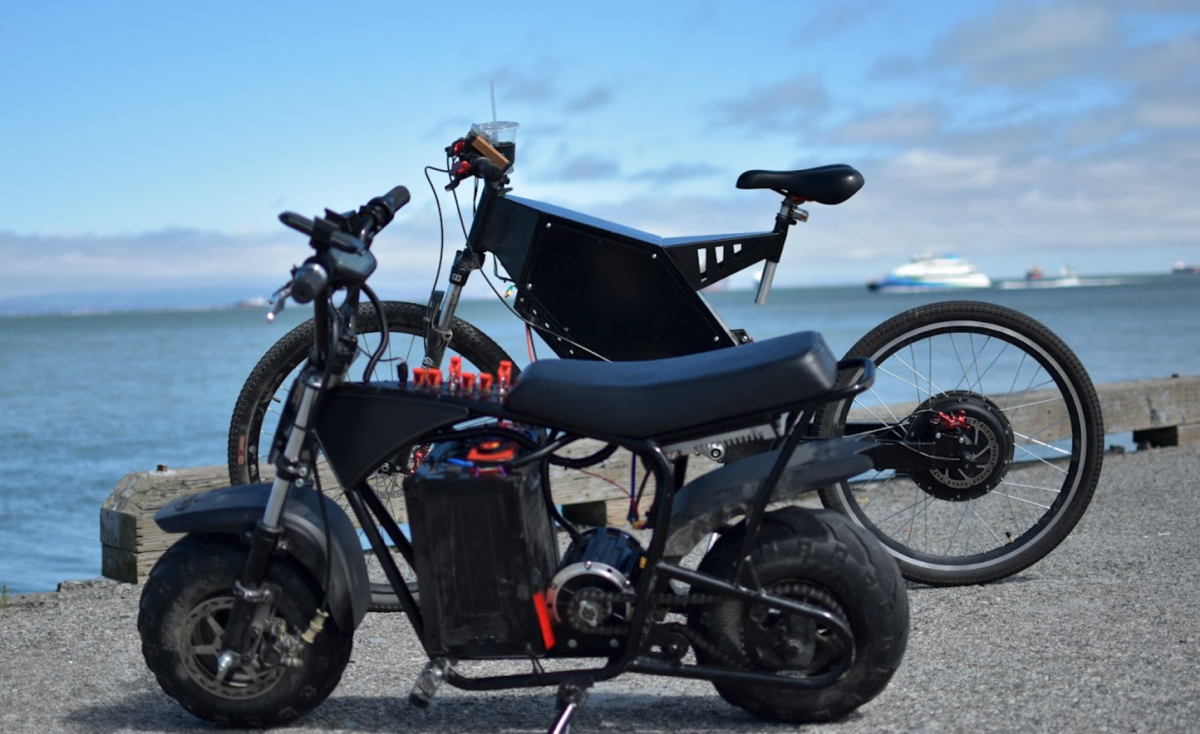A high-pitched, electric whirr projects outward as a group of students jog alongside their homemade vehicle, a three-wheeled, open-air contraption with solar panels mounted on the roof.
Capable of accelerating up to 60 mph, this electric vehicle differs from a mass-produced Tesla in its significance to Paly — it was built by students to compete in the 30th Annual Solar Car challenge in June. The challenge consists of a 1,400-mile cross-country race for eight days from Fort Worth, Texas to Palm Springs, Calif. Palo Alto Solar Vehicle is just one out of the many ways that students experiment with home-built vehicles.
Though the students road-tested the vehicle, junior Liam Livingston said weather-related difficulties impeded the ability of the team to participate.
“We pulled out of the race because of heat concerns,” Livingston said. “Then the race also got canceled halfway through (because) some of the people and staff had health issues.”
Team captain and junior Manasvi Noronha said potential improvements to the vehicle could have mitigated the heat-related issues that the team experienced this year.
“Our car was open, and there were no coverings,” Noronha said. “We had one fan on the side which was put in a risky position. (Next year) we’re planning on making sure that our drivers are safe and that the vehicle is covered so that they have more protection from the heat. It was 118 degrees.”
Despite the setback, Livingston said the team hopes to participate in a more conventional motor race with a circular track next year.
“We’re starting back up back up soon, and I’ll also be teaching people how to build electronics,” Livingston said. “Next year is going to be a track race. It’s the same organizer and it’s still in Texas.”
Livingston also said the team hopes to expand beyond the solar car competition with a new sponsor this year.
“I’m planning to build a go-kart as an opportunity to teach people how to build and work on electronics,” Livingston said. “It’ll be sponsored by the Miraj Race Club, an organization that’s above the solar car team that will be able to sponsor other events similar to it.”
Noronha said efforts to expand include more than just new competitions, as the team hopes to recruit a broader demographic of people.
“Hopefully, we’re looking to get some new members either from school, or we have applications open in Gunn too,” Noronha said. “We will definitely need a lot more people for this year, and we’re looking for people who can be on the business team or be able to code.”
Student-produced vehicles, however, can include more than just automobiles. Junior Max Dixon, another member of the team, said his creations have ranged from land-based to water-based transportation.
“When I joined I saw a couple of the seniors had e-bikes, and I wanted one of my own,” Dixon said. “I made the e-bike, minibike, and now we have the boat.”
Not as quick as his other builds, Dixon said the boat offers a chance to see the Bay as a means of leisure.
“The boat is slow. It’s a cruising boat,” Dixon said. “We take it out to the Bay and it could probably run for 25 miles. If we have a lot of batteries, it could probably go 50 miles.”
Students can build vehicles through other means as well. Instructor Doyle Knight said Auto Shop classes can offer additional creative outlets for students to build vehicles.
“We started an Auto 3 class, and we’re making electric vehicles,” Knight said. “The kids have done the majority of it. I guided them along, but they built an electric go-kart and electric little scooter. Several years ago I had guys make a motorized electric desk.”
Knight said students can also modify pre-existing vehicles as an alternative to building from scratch.
“We’re taking a golf cart and changing the type of batteries that are in it while making it more modernized,” Knight said.
Livingston’s journey into building home-made vehicles began with a modified electric bicycle.
Self-building an electric bicycle, Livingston said, taught him the intricacies of how the bicycle works.
“The second one I built during the first semester of sophomore year I have ridden over 1500 miles on it,” Livingston said. “I use it all the time. Whenever it breaks, I know exactly what’s wrong with it. So I can just fix it right away.”
Additionally, Livingston said building an electric bicycle can help save money in multiple ways. He said if offers a cheaper alternative compared to pre-built electric bicycles spending money on a car.
“The bikes that you can buy cost almost $1,000 for even the cheapest ones,” Livingston said. “But my first bike I built for $250. Before if I wanted to go somewhere further, I would have to ask my parents to drive.”
Even now, (if I want to drive) I have to go get a license, have car insurance and pay for the car and gas.”
Overall, Dixon said building vehicles could offer a positive experience for anyone.
“Anybody who wants to build something should probably just commit to it because it’s a great experience,” Dixon said. “Once you build one thing, you’ll probably get it started as a hobby.”


